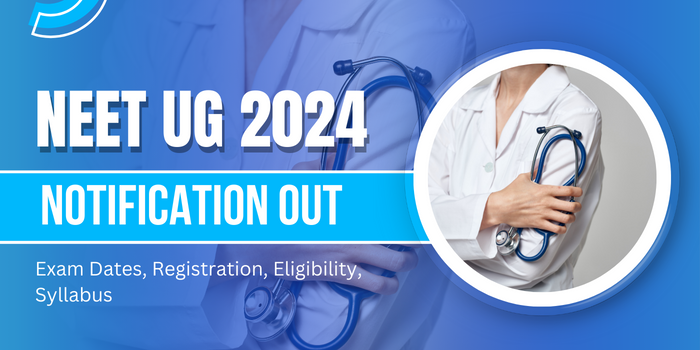
NEET UG 2024: Exam Date Out (May 5), Eligibility, Syllabus, Registration, Preparation Tips
NEET 2024 is expected to take place on May 5, 2024. The National Eligibility and Entrance Test, or NEET 2024 for short, is a well-known and highly competitive medical entrance exam in India. The NEET 2024, administered by the National Testing Agency (NTA), is the first step for students hoping to get enrolled in undergraduate medical and dental programmes. The NEET 2024 Notification gives important details regarding the exam, such as important dates, prerequisites, and the application procedure. Students must ensure to apply online for the NEET Exam within the dates for NEET UG Application.
NEET 2024 Update: Check out NEET 2024 revised syllabus
![]() NEET 2024 Application Form has been released from February 9, 2024. Check here for application form details.
NEET 2024 Application Form has been released from February 9, 2024. Check here for application form details.
NEET 2024 Exam Pattern & Syllabus has been released through online mode. Check NEET 2024 Exam Pattern & NEET 2024 Syllabus details here.
NEET 2024 Exam Date has been announced. The exam will be held on May 5, 2024 (Confirmed).
NEET 2024 Highlights
| Name of the Exam | National Eligibility cum Entrance Test |
| Conducting Body | National Testing Agency |
| Frequency of Conduction | Once a year |
| Level of the Exam | National Level |
| Languages | 13 |
| Mode of Application | Online |
| Application Fee | ₹ 1700 (General) |
| Mode of Exam | Offline |
| Mode of Counseling | Online or Offline |
| Duration of the Exam | 3 hours 20 minutes |
| Official Website | https://neet.ntaonline.in/ |
Who will conduct the NEET exam 2024?
The NEET 2024 exam in India is conducted by the National Testing Agency (NTA) on behalf of the Government of India. The NEET UG 2024 is expected to take place on May 5, 2024.
NEET 2024 Exam Dates
Since only the NEET UG 2024 Exam Date had been released we are providing you with a list of tentative dates for the other important events pertaining to the NEET UG 2024 Exam:-
| Event | Dates |
| Application Start | 9th February, 2024 |
| Application Close | 9th March, 2024 (9:00 pm) |
| Online Payment- Application Form Last Date | 9th March, 2024 (11:50 pm) |
| Application Form Correction | To be intimated later on the website |
| Admit Card Release | To be intimated later on the website |
| NEET UG 2024 Exam Date | May 5, 2024 (Confirmed) |
| Result Date | 14th June 2024 |
NTA NEET 2024 eligibility criteria
The following is the NEET 2024 Eligibility Criteria:-
| Eligibility Criteria | Details |
| 1. Age Requirements |
|
| 2. Citizenship |
|
| 3. Qualifying Exam |
|
| 4. Minimum Percentage |
|
NEET 2024 Eligibility Criteria: Maximum Number of Attempts
There are no restrictions on the number of attempts for NEET UG 2024.
NEET 2024 Eligibility Criteria: NRI, OCI, and Foreign Nationals
| Information | Details |
| 1. Eligibility for Admission |
|
| 2. Documentation for NRI and OCI Candidates |
|
| 3. Documentation for Foreign Nationals |
|
| 4. Documentary Proof of Citizenship |
|
| 5. Confirmation of Eligibility |
|
NEET 2024 Eligibility Criteria: Age Limit
The upper age limit for NEET 2024 has been removed. Candidates above 17 years of age can apply, eliminating the previous age limits of 25 years for the general category and 30 years for reserved category candidates.
NEET 2024 Eligibility Criteria: Qualifying Marks
| 1.General and General-EWS Candidates |
|
| 2. Scheduled Castes, Scheduled Tribes, and Other Backward Classes |
|
| 3.Persons with Benchmark Disabilities (PwBD) |
|
| 4.Students who received education abroad |
|
NEET 2024 Eligibility Criteria: All India Quota Seats/Deemed Universities/Central Universities/ESIC and AFMC Colleges
Aspirants who successfully pass the NEET UG 2024 exam will have the opportunity to apply for various categories of seats, including the 15% All India Quota seats. However, candidates from the state of Jammu and Kashmir (J&K) will not automatically be eligible for the 15% All India Quota seats. To be considered for these seats, they must complete a self-declaration form, which should be submitted along with their NEET application for 2024. This self-declaration indicates the candidate’s intention to participate in the counseling for the 15% All India Quota seats and signals their willingness to forgo the home state counseling process.
Also See :
- NEET UG 2024
- NEET UG Application form 2024
- NEET Exam pattern 2024
- NEET Admit card 2024
- NEET Syllabus 2024
- NEET Result 2024
NEET 2024 Eligibility Criteria: State Quota Seats
The 85% state quota seats refer to the seats available in all government colleges within each state and union territory. To be eligible to apply for state quota seats, candidates must meet the NEET 2024 eligibility criteria specified by the state or union territory, which may include domicile requirements.
NEET UG 2024 Application Process
The following is the step by step NEET 2024 Application Process:-
Step 1: NEET 2024 Registration
- To initiate the NEET 2024 application process, candidates need to click on the “Fill Application Form” button.
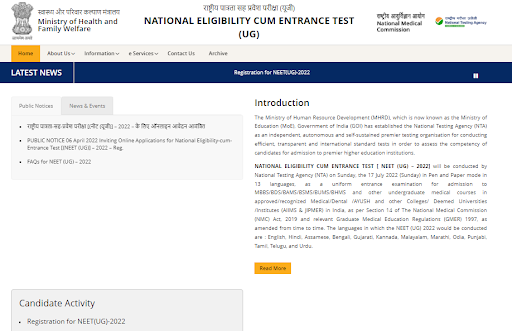
- On the new page, select “New Registration,” which will direct you to the instructions page that should be read thoroughly.
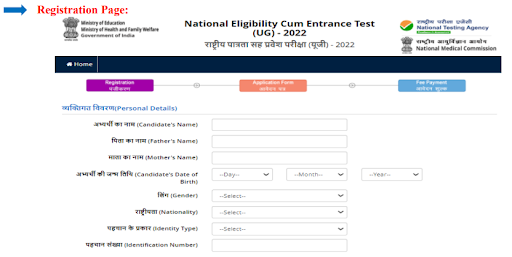
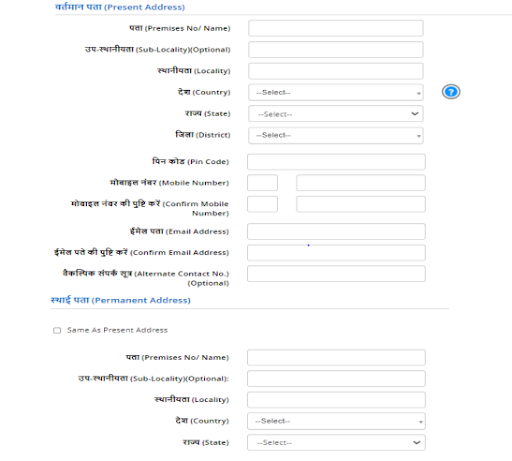
- During the NEET-UG registration, you’ll be required to provide various details, including creating a password following specified guidelines. This password will be used for all future logins.
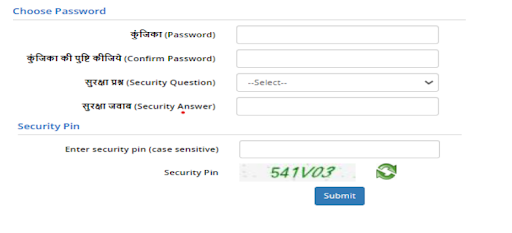
- Upon successful registration, a provisional application number will be generated. This serves as your user ID for logging into neet.nta.nic.in in 2024.

- The following details must be entered during the NEET application form filling:
- Candidate’s Name
- Mother’s Name
- Father’s Name
- Date of Birth
- Gender
- Nationality
- State of Eligibility
- Category
- Person with Disabilities
- Identification Type
- Identification Number
- Mobile Number
- Email ID
- Security Pin (as displayed on the screen)
- Candidates should also select and confirm a password, security question, and answer for future password retrieval.
Step 2: Completing the NEET 2024 Application
- After registration, click on “Complete Application Form.”
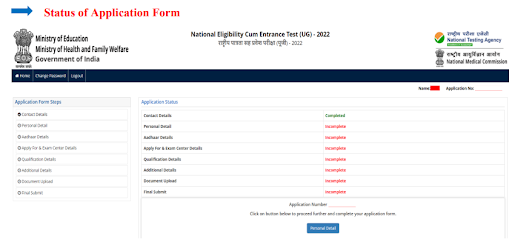
- Log in using the provisional registration number and password.
- You must fill in remaining details in the NEET 2024 application form, including:
- Personal Details (some details will be auto-generated)
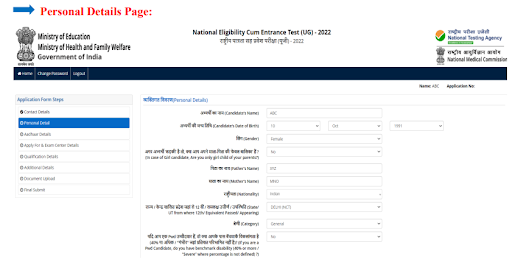
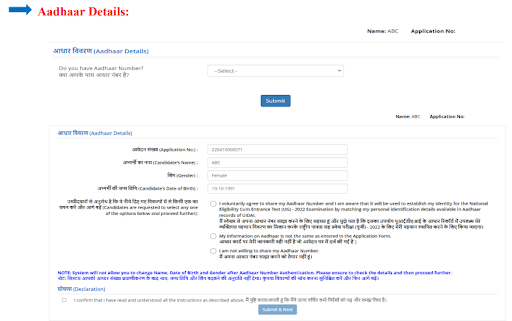
- Apply for NEET
- Academic Details (Class 12 or equivalent)
Step 3: Uploading Scanned Documents and Images
- After providing application details, upload scanned copies of your photograph, signature, left-hand thumb impression, and postcard size photograph among other necessary documents following specified guidelines.
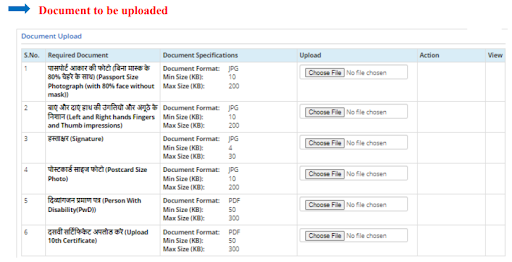
Step 4: NEET Application Fee Payment
- Once documents are uploaded, you’ll have the option to pay the NEET 2024 application fee.
- The fee can be paid online and varies for different categories (general, OBC/ST/SC, and EWS).
- Select the payment mode and provider (online payment options are available).
- Keep proof of payment (transaction ID/receipt) for reference.
NEET 2024 Application Process- Documents required and image specifications
While filling out the NEET 2024 Application Form the following list of documents are essential for the candidate to have with them. It is to be noted that the candidates have to scan images of the following in JPG /PDF format only:-
| Documents Required | Format | Image Specifications |
| 1. Latest Passport size Photograph | JPG format | 10 kb to 200 kb |
| 2. Post Card size photograph (4” X 6”) | JPG format | 10 kb to 200 kb |
| 3. Signature | JPG format | 4 kb to 30 kb |
| 4. Left and Right hand Fingers and Thumb impressions | JPG format | 10 kb to 200 kb |
| 5. Class 10 passed certificate | PDF format | 50 kb to 300 kb |
| 6. Category certificate (SC/ST/OBC-NCL/EWS, etc.) | PDF format | 50 kb to 300 kb |
| 7. PwBD certificate | PDF format | 50 kb to 300 kb |
| 8. Citizenship Certificate/ Embassy Certificate or any Documentary proof of Citizenship certificate | PDF format | 50 kb to 300 kb |
| 9. Address proof of present and permanent address of the candidate | PDF format | 50 kb to 300 kb |
NEET 2024 Application Fee
The following is the NEET UG 2024 Application Fee:-
| Category of Candidate | In India (Fee in ₹) |
| General | ₹ 1700/- |
| General -EWS/ OBC-NCL | ₹ 1600/- |
| SC/ST/PwBD/Third Gender | ₹ 1000/- |
NEET Admit Card 2024
The NEET Admit Card 2024 is a crucial document issued to candidates appearing for the NEET 2024. It serves as an official confirmation of the candidate’s eligibility to take the exam and includes essential details such as the candidate’s name, roll number, exam center, date, and timing. To ensure a smooth and secure examination process, candidates are required to carry the NEET Admit Card 2024 along with valid identification to the exam center. It is a mandatory document for entry into the examination hall, and candidates are advised to keep it safe throughout the NEET 2024 examination process.
How to download NEET 2024 Admit Card?
Step 1- Access the official website neet.nta.nic.in.
- Visit the official NEET website.
Step 2- Click on the NEET 2024 admit card login link after it becomes available.
- Once the link for the NEET 2024 admit card is accessible, click on it.
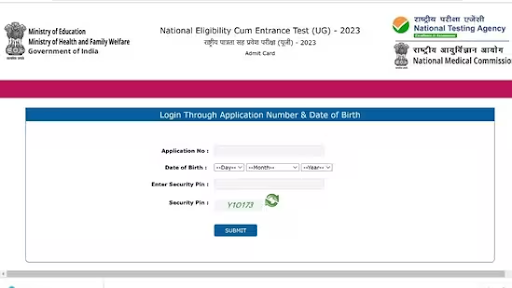
Step 3- On the portal, provide your application number, date of birth, and the security pin.
- Fill in the required fields with your application number, date of birth, and the security pin.
Step 4- Submit the information.
- After entering the details, click on the “Submit” button.
Step 5- The NEET 2024 admit card will be displayed on the screen.
- You’ll be able to view and access your NEET 2024 admit card on the screen.
Step 6- Verify the information mentioned on the NEET admit card 2024. Report any discrepancies to the authorities immediately.
- Carefully review all the details provided on the NEET admit card for accuracy. If you notice any discrepancies, it’s essential to promptly inform the relevant authorities.
Step 7- Download the NEET 2024 admit card and keep 3-4 printed copies for future use.
- Download the NEET 2024 admit card and make sure to retain 3-4 printed copies for your reference.
Step 8- Ensure that the parent’s signature is included in the designated space on the NEET admit card 2024.
- Don’t forget to have your parent or guardian sign in the specified area on the NEET admit card for 2024.
NEET 2024 Admit Card- Details Mentioned
When accessing the NEET 2024 Admit Card it is vital that the candidate ensures that the following details are mentioned in the NEET 2024 Admit Card for it to be considered valid:-
- Name of the Candidate
- Father’s name
- Date of birth
- Gender
- Application number
- Roll number
- QR code
- Category of applicant
- Sub-category
- NEET 2024 exam date and time
- Reporting time and time for last entry
- Address of aspirant
- Language (medium) of question paper
- NEET exam center name and address
- Exam center number
- Passport-size photograph (uploaded in the application form)
- Signature (uploaded during registration)
- The IP address and date of downloading of admit card
- Space to paste passport-size photograph (same as used during registration)
- Signature of the candidate (to be done in the exam hall in front of the invigilator)
- Signature of parent
- NEET-UG senior director signature
- Other general instructions to be followed
If there are any inaccuracies in the candidate’s details, photograph, or signatures as they appear on the Admit Card and Confirmation Page, the candidate should promptly contact the Helpline between 10:00 am and 5:00 pm. In these situations, candidates should still use the Admit Card they’ve already downloaded to attend the examination. However, the NTA (National Testing Agency) will address and rectify the discrepancies in the records at a later time.
NEET 2024 Exam Pattern
The test pattern for NEET (UG) – 2024 consists of four subjects, each having two sections. Section A comprises 35 questions, while Section B contains 15 questions, of which candidates can choose to answer any 10. The total number of questions and the time allocation remain consistent.
The NEET UG 2024 examination pattern is as follows:
| Sections | Number of Questions | Total Marks |
| Physics Section A | 35 | 140 |
| Physics Section B | 15 | 40 |
| Chemistry Section A | 35 | 140 |
| Chemistry Section B | 15 | 40 |
| Botany Section A | 35 | 140 |
| Botany Section B | 15 | 40 |
| Zoology Section A | 35 | 140 |
| Zoology Section B | 15 | 40 |
| Total Marks | 720 | |
1. For Section A (MCQs):
In Section A, candidates are required to choose the correct or most suitable option as their response to each question. In the event of any discrepancies arising during the key verification process, they will be addressed as follows:
- Selecting the correct or most appropriate answer will earn candidates four marks (+4).
- Opting for an incorrect option will result in a deduction of one mark (-1).
- Leaving a question unanswered will not be awarded any marks (0).
- When multiple correct options are identified, candidates who select any of them will receive four marks (+4).
- If all options within a question are correct, all candidates who attempted the question will be granted four marks (+4).
- Even if none of the options in a question is correct, or if a question is found to be incorrect or is removed, all candidates who made an attempt will receive four marks (+4), regardless of whether they answered it or not.
2. For Section B (MCQs):
In Section B, candidates are required to respond to any 10 questions out of the 15 provided. Should a candidate choose to answer more than 10 questions, only the first 10 answered questions will be taken into consideration for evaluation. Negative marking is applicable to Section B, and any anomalies or discrepancies that arise following the key verification process will be handled as follows:
- Providing the correct answer will result in four marks (+4).
- An incorrect response will lead to a deduction of one mark (-1).
- Unanswered questions will not receive any marks (0).
- When multiple correct options exist in a question, candidates who mark any of them will be awarded four marks (+4).
- If all options in a question are correct, all candidates who attempted the question will receive four marks (+4).
- In cases where a question is identified as incorrect or is removed, all candidates who attempted the question will be awarded four marks (+4). This may be due to human or technical errors. Candidates are advised to take into account any constants provided in the questions when performing calculations.
NEET 2024 is a traditional paper-and-pen test, where candidates mark their responses on a specially designed machine-readable OMR sheet using a ballpoint pen provided at the examination center. It’s essential to emphasize that any tampering with the OMR sheet at any point will lead to the candidate’s disqualification for a period of three years.
The test’s duration is three hours and twenty minutes. For PwBD (Persons with Benchmark Disabilities) candidates, who may have physical limitations affecting their ability to write, an additional compensatory time of one hour and five minutes is granted for an examination that originally spans three hours and twenty minutes (03:20 hrs). This additional time is provided whether or not the candidate uses a scribe.
Following the principles outlined in the National Education Policy (NEP), NEET (UG) – 2024 is conducted in various languages, including English, Hindi, Assamese, Bengali, Gujarati, Kannada, Malayalam, Marathi, Odia, Punjabi, Tamil, Telugu, and Urdu.
NEET 2024 Syllabus
The NEET syllabus 2024 is the comprehensive content outline for the National Eligibility cum Entrance Test for undergraduate medical and dental programs in India. This syllabus serves as a guideline for the topics and subjects that candidates are expected to be familiar with for the examination.
It encompasses various subjects, including Physics, Chemistry, Biology/Biotechnology, and is designed to assess the knowledge and competence of aspiring medical professionals. Candidates preparing for NEET are required to have a thorough understanding of the syllabus to excel in the examination and secure admission to medical and dental colleges.
The NEET 2024 Syllabus once released can be found on the official website, i.e., https://www.nmc.org.in/neet/neet-ug/.
NEET Syllabus Update: Revised NEET Syllabus 2024
NEET 2024 Syllabus: Biology
The following is the detailed and in- depth NEET 2024 Syllabus for Biology:-
Unit I: Diversity in Living World
- What is living?; Biodiversity; Need for classification; Taxonomy & Systematics; Concept of species and taxonomic hierarchy; Binomial nomenclature.
- Five kingdom classifications; salient features and classification of Monera; Protista and Fungi into major groups; Lichens; Viruses and Viroids.
- Salient features and classification of plants into major groups – Algae, Bryophytes, Pteridophytes, Gymnosperms (three to five salient and distinguishing features and at least two examples of each category);.
- Salient features and classification of animals-nonchordate up to phyla level and chordate up to classes level (three to five salient features and at least two examples)
Unit II: Structural Organisation in Animals and Plants
- Morphology and modifications; Tissues; Anatomy and functions of different parts of flowering plants: Root, stem, leaf, inflorescence- cymose and racemose, flower, fruit and seed (To be dealt along with the relevant practical of the Practical Syllabus). Family (malvaceae, Cruciferae, leguminoceae, compositae, gramineae).
- Animal tissues; Morphology, anatomy and functions of different systems (digestive, circulatory, respiratory, nervous and reproductive) of an insect (frog). (Brief account only)
Unit III: Cell Structure and Function
- Cell theory and cell as the basic unit of life; Structure of prokaryotic and eukaryotic cell; Plant cell and animal cell; Cell envelope, cell membrane, cell wall; Cell organelles-structure and function; Endomembrane system-endoplasmic reticulum, Golgi bodies, lysosomes, vacuoles; mitochondria, ribosomes, plastids, micro bodies; Cytoskeleton, cilia, flagella, centrioles (ultra structure and function); Nucleus-nuclear membrane, chromatin, nucleolus.
- Chemical constituents of living cells: Biomolecules-structure and function of proteins, carbohydrates, lipids, nucleic acids; Enzymes-types, properties, enzyme action, classification and nomenclature of enzymes.
- B Cell division: Cell cycle, mitosis, meiosis and their significance.
Unit IV: Plant Physiology
- Photosynthesis: Photosynthesis as a means of Autotrophic nutrition; Site of photosynthesis take place; pigments involved in Photosynthesis (Elementary idea); Photochemical and biosynthetic phases of photosynthesis; Cyclic and non cyclic and photophosphorylation; Chemiosmotic hypothesis; Photorespiration C3 and C4 pathways; Factors affecting photosynthesis.
- Respiration: Exchange gasses; Cellular respiration-glycolysis, fermentation (anaerobic), TCA cycle and electron transport system (aerobic); Energy relations- Number of ATP molecules generated; Amphibolic pathways; Respiratory quotient.
- Plant growth and development: Seed germination; Phases of Plant growth and plant growth rate; Conditions of growth; Differentiation, dedifferentiation and redifferentiation; Sequence of developmental process in a plant cell; Growth regulators-auxin, gibberellin, cytokinin, ethylene, ABA.
Unit V: Human physiology
- Breathing and Respiration: Respiratory organs in animals (recall only); Respiratory system in humans; Mechanism of breathing and its regulation in humans-Exchange of gasses, transport of gasses and regulation of respiration Respiratory volumes; Disorders related to respiration-Asthma, Emphysema, Occupational respiratory disorders.
- Body fluids and circulation: Composition of blood, blood groups, coagulation of blood; Composition of lymph and its function; Human circulatory system-Structure of human heart and blood vessels; Cardiac cycle, cardiac output, ECG, Double circulation; Regulation of cardiac activity; Disorders of circulatory system-Hypertension, Coronary artery disease, Angina pectoris, Heart failure.
- Excretory products and their elimination: Modes of excretion- Ammonotelism, ureotelism, uricotelism; Human excretory system-structure and function; Urine formation, Osmoregulation; Regulation of kidney function-Renin-angiotensin, Atrial Natriuretic Factor, ADH and Diabetes insipidus; Role of other organs in excretion; Disorders; Uraemia, Renal failure, Renal calculi, Nephritis; Dialysis and artificial kidney.
- Locomotion and Movement: Types of movement- ciliary, flagellar, muscular; Skeletal muscle contractile proteins and muscle contraction; Skeletal system and its functions (To be dealt with the relevant practical of Practical syllabus); Joints; Disorders of muscular and skeletal systemMyasthenia gravis, Tetany, Muscular dystrophy, Arthritis, Osteoporosis, Gout.
- Neural control and coordination: Neuron and nerves; Nervous system in humans central nervous system, peripheral nervous system and visceral nervous system; Generation and conduction of nerve impulse; Reflex action; Sense organs; Elementary structure and function of eye and ear.
- Chemical coordination and regulation: Endocrine glands and hormones; Human endocrine systemHypothalamus, Pituitary, Pineal, Thyroid, Parathyroid, Adrenal, Pancreas, Gonads; Mechanism of hormone action (Elementary Idea); Role of hormones as messengers and regulators, Hypo-and hyperactivity and related disorders (Common disorders e.g. Dwarfism, Acromegaly, Cretinism, goiter, exophthalmic goiter, diabetes, Addison’s disease). (Imp: Diseases and disorders mentioned above to be dealt with briefly.)
Unit VI: Reproduction
- Sexual reproduction in flowering plants: Flower structure; Development of male and female gametophytes; Pollination-types, agencies and examples; Outbreeding devices; Pollen-Pistil interaction; Double fertilization; Post fertilization events- Development of endosperm and embryo, Development of seed and formation of fruit; Special modes-apomixis, parthenocarpy, polyembryony; Significance of seed and fruit formation.
- Human Reproduction: Male and female reproductive systems; Microscopic anatomy of testis and ovary; Gametogenesis-spermatogenesis & oogenesis; Menstrual cycle; Fertilisation, embryo development upto blastocyst formation, implantation; Pregnancy and placenta formation (Elementary idea); Parturition (Elementary idea); Lactation (Elementary idea).
- Reproductive health: Need for reproductive health and prevention of sexually transmitted diseases (STD); Birth control-Need and Methods, Contraception and Medical Termination of Pregnancy (MTP); Amniocentesis; Infertility and assisted reproductive technologies – IVF, ZIFT, GIFT (Elementary idea for general awareness)
Unit VII: Genetics and Evolution
- Heredity and variation: Mendelian Inheritance; Deviations from Mendelism- Incomplete dominance, Codominance, Multiple alleles and Inheritance of blood groups, Pleiotropy; Elementary idea of polygenic inheritance; Chromosome theory of inheritance; Chromosomes and genes; Sex determination-In humans, birds, honey bee; Linkage and crossing over; Sex linked inheritance-Haemophilia, Colour blindness; Mendelian disorders in humans-Thalassemia; Chromosomal disorders in humans; Down’s syndrome, Turner’s and Klinefelter’s syndromes.
- Molecular basis of Inheritance: Search for genetic material and DNA as genetic material; Structure of DNA and RNA; DNA packaging; DNA replication; Central dogma; Transcription, genetic code, translation; Gene expression and regulation- Lac Operon; Genome and human genome project; DNA fingerprinting, protein biosynthesis.
- Evolution: Origin of life; Biological evolution and evidences for biological evolution from Paleontology, comparative anatomy, embryology and molecular evidence); Darwin’s contribution, Modern Synthetic theory of Evolution; Mechanism of evolution-Variation (Mutation and Recombination) and Natural Selection with examples, types of natural selection; Gene flow and genetic drift; Hardy-Weinberg’s principle; Adaptive Radiation; Human evolution.
Unit VIII: Biology and Human Welfare
- Health and Disease; Pathogens; parasites causing human diseases (Malaria, Filariasis, Ascariasis. Typhoid, Pneumonia, common cold, amoebiasis, ringworm); Basic concepts of immunology vaccines; Cancer, HIV and AIDS; Adolescence, drug and alcohol abuse, Tobacco abuse.
- Improvement in food production; Plant breeding, tissue culture, single cell protein, Biofortification; Apiculture and Animal husbandry.
- Microbes in human welfare: In household food processing, industrial production, sewage treatment, energy generation and as biocontrol agents and biofertilizers.
Unit IX: Biotechnology and Its Applications
- Principles and process of Biotechnology: Genetic engineering (Recombinant DNA technology).
- Application of Biotechnology in Health and Agriculture: Human insulin and vaccine production, gene therapy; Genetically modified organisms-Bt crops; Transgenic Animals; Biosafety issuesBiopiracy and patents.
Unit X: Ecology and Environment
- Organisms and environment: Population interactions-mutualism, competition, predation, parasitism; Population attributes-growth, birth rate and death rate, age distribution.
- Ecosystem: Patterns, components; productivity and decomposition; Energy flow; Pyramids of number, biomass, energy.
- Biodiversity and its conservation: Concept of Biodiversity; Patterns of Biodiversity; Importance of Biodiversity; Loss of Biodiversity; Biodiversity conservation; Hotspots, endangered organisms, extinction, Red Data Book, biosphere reserves, National parks and sanctuaries, Sacred Groves.
- Environmental issues: Air pollution and its control; Water pollution and its control; Agrochemicals and their effects; Solid waste management; Radioactive waste management; Greenhouse effect and global warming; Ozone depletion; Deforestation; Any three case studies as success stories addressing environmental issues.
NEET 2024 Syllabus: Chemistry
The following is the detailed and in- depth NEET 2024 Syllabus for Chemistry:-
Physical Chemistry Syllabus for NEET 2024
There are a total of eight units under the Physical Chemistry section for NEET 2024. The unit-wise chapters and topics are given below.
Unit I: Some Basic Concepts of Chemistry
Matter and its nature, Dalton’s atomic theory: Concept of atom, molecule, element. and compound. Laws of chemical combination; Atomic and molecular masses, mole concept, molar mass, percentage composition, empirical and molecular formulae: Chemical equations and
stoichiometry.
Unit II: Atomic Structure
Nature of electromagnetic radiation, photoelectric effect; Spectrum of the hydrogen atom. Bohr model of a hydrogen atom – its postulates, derivation of the relations for the energy of the electron and radii of the different orbits, limitations of Bohr’s model; Dual nature of r,letter, de Broglie’s relationship. Heisenberg uncertainty principle. Elementary ideas of quantum mechanics, quantum mechanics, the quantum mechanical model of the atom, its important features. Concept of atomic orbitals as one-electron wave functions: Variation of Ψ and Ψ 2 with r for 1s and 2s orbitals: various quantum numbers (principal, angular momentum, and magnetic quantum numbers) and their significance; shapes of s, p, and d – orbitals, electron spin and spin quantum number: Rules for filling electrons in orbitals – Aufbau principle. Pauli’s exclusion principle and Hund’s rule, electronic configuration of elements, extra stability of half-filled and completely filled orbitals.
Unit III: Chemical Bonding and Molecular Structure
Kossel – Lewis approach to chemical bond formation, the concept of ionic and covalent bonds.
Ionic Bonding: Formation of ionic bonds, factors affecting the formation of ionic bonds; calculation of lattice enthalpy.
Covalent Bonding: Concept of electronegativity. Fajan’s rule, dipole moment: Valence Shell Electron Pair Repulsion (VSEPR) theory and shapes of simple molecules.
Quantum mechanical approach to covalent bonding: Valence bond theory – its important features. the concept of hybridization involving s, p, and d orbitals; Resonance.
Molecular orbital Theory – Its important features. LCAOs, types of molecular orbitals (bonding, antibonding), sigma and pi-bonds, molecular orbital electronic configuration of homonuclear diatomic molecules, the concept of bond order, bond length, and bond energy.
Elementary idea of metallic bonding. Hydrogen bonding and its applications.
Unit IV: Chemical Thermodynamics
Fundamentals of thermodynamics: System and surroundings, extensive and intensive properties’ state functions, types of processes.
The first law of thermodynamics – Concept of work, heat internal energy and enthalpy, heat capacity, molar heat capacity; Hess’s law of constant heat summation; Enthalpies of bond dissociation, combustion’ formation, atomization. sublimation. phase transition, hydration. ionization. and solution.
The second law of thermodynamics – Spontaneity of processes: AS of the universe and AC of the system as criteria for spontaneity. Standard Gibbs energy change and equilibrium constant.
The following paragraphs bring the important topics from the NEET syllabus 2024 for Chemistry and their weightage.
Unit V: Solutions
Different methods for expressing the concentration of solution – molality, molarity, mole fraction. percentage (by volume and mass both), the vapor pressure of solutions and Raoult’s law – Ideal and.non-ideal solutions, vapor pressure – composition, plots for ideal and non-ideal solutions: colligative properties of dilute solutions – a relative lowering of vapor pressure, depression of freezing point, the elevation of.boiling point and osmotic pressure; Determination of molecular mass using colligative properties; Abnormal value of molar mass, Van’t Hoff Factor and its significance.
Unit VI: Equilibrium
Meaning of equilibrium, the concept of dynamic equilibrium.
Equilibria involving physical processes: Solid-liquid, liquid – gas and solid-gas equilibria, Henry’s law. General characteristics of equilibrium involving physical processes.
Equilibrium involving chemical processes: Law of chemical equilibrium, equilibrium constants (Kp and Kc) and their significance, the significance of ΔG and ΔG° in chemical equilibrium, factors affecting equilibrium concentration, pressure, temperature, the effect of catalyst; Le Chatelier’s principle.
Ionic equilibrium: weak. and strong electrolytes, ionization of electrolytes, various concepts of acids and bases (Arrhenious and Bronsted – Lowry and Lewis) and their ionization, acid-base equilibria (including multi stage ionization) and ionization constants, ionization of water. PH scale, common ion effect, hydrolysis of salts and PH of their solutions, the solubility of sparingly soluble salts and solubility products, buffer solutions.
Unit VII: Redox Reactions and Electrochemistry
Electronic concepts of oxidation reduction, redox reactions, oxidation numbers, rules for assigning oxidation number, balancing of redox reactions.
Electrolytic and metallic conduction, conductance in electrolytic solutions, molar conductivities and their variation with concentration, Kohlrausch’s law and its applications.
Electrochemical Cells – Electrolytic and Galvanic cells, different types of electrodes, electrode potentials including standard electrode potential, half – cell and cell reactions, emf of a Galvanic cell and its measurement: Nernst equation and its applications; Relationship between cell potential and Gibbs’ energy change: Dry cell and lead accumulator; Fuel cells.
Unit VIII: Chemical Kinetics
Rate of a chemical reaction, factors affecting the rate of reactions: concentration, temperature, pressure,’and catalyst; elementary and complex reactions, rate law, rate constants and its units, differential and integral forms of zero and first-order reactions, their characteristics and half lives, the effect of temperature on the rate of reactions, Arrhenius theory, activation energy and its calculation, collision theory of bimolecular gaseous reactions (no derivation).
Inorganic Chemistry Syllabus for NEET 2024
The Inorganic Chemistry section has four units:-
Unit IX: Classification in Elements and Periodicity in Properties
Modern periodic law and present form of periodic table, s, p, d and f block elements, periodic trends in properties of elements of atomic and ionic radii, ionization enthalpy, electron gain enthalpy, valence, oxidation states, and chemical reactivity.
Unit X: P-Block Elements
Group 13 to Group 18 Elements
General Introduction: Electronic configuration and general trends in physical and chemical properties of elements across the periods and down the groups; unique behavior of the first element in each group.
Unit XI: d and f Block Elements
Transition Elements
General introduction, electronic configuration, occurrence and characteristics, general trends in properties, of the first row transition elements – physical properties, ionization enthalpy, oxidation states, atomic radii, color, catalytic behavior, magnetic properties, complex formation, interstitial compounds, alloy formation; Preparation, properties and uses of K2Cr207 and KMn04.
Inner Transition Elements
Lanthanoids – Electronic configuration, oxidation states, and lanthanide contraction.
Actinides – Electronic configuration and oxidation states.
Unit XII: Coordination Compounds
Introduction to coordination compounds.Wemer’s theory; ligands, coordination number. denticity. chelation; IUPAC nomenclature of mononuclear coordination compounds, isomerism: Bonding-Valence bond approach and basic ideas of Crystal field theory,color and magnetic properties; importance of coordination compounds (in qualitative analysis. extraction of metals and in biological systems).
Organic Chemistry Syllabus for NEET 2024
The Organic Chemistry section has eight units highest of all the sections:-
Unit XIII: Purification and Characterisation of Organic Compounds
Purification – Crystallization. sublimation, distillation, differential extraction, chromatography – principles and their applications.
Qualitative analysis – Detection of nitrogen, sulfur, phosphorus and halogens.
Quantitative analysis (basic principles only) – Estimation of carbon. hydrogen. nitrogen. halogens. sulfur. phosphorus.
Calculations of empirical formula and molecular formulae: Numerical problems in organic quantitative analysis.
Unit XIV: Some Basic Principles of Organic Chemistry
Tetravalency of carbon: Shapes of simple molecules – hybridization (s and p): classification of organic compounds based on functional groups: and those containing halogens, oxygen, nitrogen and sulfur; Homologous series: Isomerism – structural and stereoisomerism.
Nomenclature (Trivial and IUPAC)
Covalent bond fission – Homolytic and heterolytic: free radicals. carbocations. and carbanions: stability of carbocations and free radicals. electiophires. and nucleophiles.
Electronic displacement in a covalent bond
Inductive effect, electromeric effect. resonance and hyperconjugation.
Common types of organic reactions- Substitution. addition. elimination, and rearrangement.
Unit XV: Hydrocarbons
Classification’ isomerism. IUPAC nomenclature, general methods of preparation, properties, and reactions.
Alkanes – Conformations: Sawhorse and Newman projections (of ethane): Mechanism of halogenation of alkanes, projections (of ethane).
Alkenes – Geometrical isomerism: Mechanism of electrophilic addition: addition of hydrogen. halogens, water. hydrogen halides (Markownikoffs and peroxide effect): Ozonolysis and polymerization.
Alkynes – Acidic character: Addition of hydrogen, halogens, water, and hydrogen halides: Polymerization.
Aromatic hydrocarbons – Nomenclature. benzene – structure and aromaticity: Mechanism of substitution: halogenation, nitration.
Friedel- Crafts alkylation and acylation, directive influence of the functional group in mono-substituted benzene.
Unit XVI: Organic Compounds Containing Halogen
General methods of preparation, properties, and reactions; Nature of C-X bond: Mechanisms of substitution reactions.
Uses; Environmental effects of chloroform, iodoform freons, and DDT.
Unit XVII: Organic Compound Containing Oxygen
General methods of preparation, properties, reactions, and uses.
Alcohols, Phenols and Ethers
Alcohols: Identification of primary, secondary, and tertiary alcohols: mechanism of dehydration.
Phenols: Acidic nature, electrophilic substitution reactions: halogenation. nitration and sulphonation. Reimer – Tiemann reaction.
Ethers: Structure.
Aldehyde and Ketones: Nature of carbonyl group; Nucleophilic addition to >C=O group, relative reactivities of aldehydes and ketones; Important reactions such as – Nucleophilic addition reactions (addition of HCN. NH3 and its derivatives), Grignard reagent; oxidation: reduction (Wolf Kishner and Clemmensen); the acidity of α-hydrogen. aldol condensation, Cannizzaro reaction. Haloform reaction, Chemical tests to distinguish between aldehydes and Ketones.
Carboxylic Acids
Acidic strength and factors affecting it.
Unit XVIII: Organic Compounds Containing Nitrogen
General methods of preparation. Properties, reactions, and uses.
Amines: Nomenclature, classification structure, basic character, and identification of primary, secondary, and tertiary amines and their basic character.
Diazonium Salts: Importance in Synthetic Organic Chemistry.
Unit XIX: Biomolecules
General introduction and importance of biomolecules.
CARBOHYDRATES – classification; aldoses and ketoses: monosaccharides (glucose and fructose) and constituent monosaccharides of oligosaccharides (sucrose, lactose, and maltose)
PROTEINS.Elementary Idea of α-amino acids, peptide bond, polypeptides.Proteins: primary. secondary, tertiary, and quaternary structure (qualitative idea only), denaturation of proteins enzymes.
VITAMINS – Classification and functions
NUCLEIC ACIDS – Chemical constitution of DNA and RNA
Biological functions of nucleic acids
Hormones (General Introduction)
Unit XX: Principles Related to Practical Chemistry
Detection of extra elements (Nitrogen, sulfur, halogens), in organic compounds; Detection of the following functional group, hydroxyl (alcoholic and phenolic), carbonyl (aldehyde and ketones) carboxyl, and amino groups in organic compounds.
- The chemistry involved in the preparation of the following:-
- Inorganic compounds: Mohr’s salt. potash alum
- Organic compounds: Acetanilide. p-nitro acetanilide, aniline yellow, iodoform
NEET 2024 Syllabus: Physics
The following is the detailed and in- depth NEET 2024 Syllabus for Physics:-
Unit I: Physics and Measurement
- Need for measurement: Units of measurement; systems of units; SI units, fundamental and derived units. errors in measurement; significant figures.
- Dimensions of physical quantities, dimensional analysis, and its applications.
Unit II: Kinematics
The frame of reference, motion in a straight line. Position- time graph. speed and velocity: Uniform and non-uniform motion. average speed and instantaneous velocity. Uniformly accelerated motion. velocity-time, position-time graph, relations for uniformly accelerated motion- Scalars and Vectors. Vector. Addition and subtraction, scalar and vector products. Unit Vector. Resolution of a Vector. Relative Velocity. Motion in a plane, Projectile Motion. Uniform Circular Motion.
Unit III: Laws of Motion
Force and inertia, Newton’s First law of motion: Momentum, Newton’s Second Law of motion, Impulses: Newton’s Third Law of motion. Law of conservation of linear momentum and its applications. Equilibrium of concurrent forces.
Static and Kinetic friction, laws of friction. rolling friction.
Dynamics of uniform circular motion: centripetal force and its applications: vehicle on a level circular road. vehicle on a banked road.
Unit IV: Work, Energy and Power
Work done by a constant force and a variable force; kinetic and potential energies. work-energy theorem, power.
The potential energy of spring conservation of mechanical energy. conservative and non-conservative forces; motion in a vertical circle: Elastic and inelastic collisions in one and two dimensions.
Unit V: Rotational Motion
Centre of the mass of a two-particle system, Centre of the mass of a rigid body: Basic concepts of rotational motion; moment of a force; torque, angular momentum, conservation of angular momentum and its applications.
The moment of inertia, the radius of gyration, values of moments of inertia for simple geometrical objects, parallel and perpendicular axes theorems. and their applications. Equilibrium of rigid bodies. rigid body rotation and equations of rotational motion, comparison of linear and rotational motions.
Unit VI: Gravitation
The universal law of gravitation. Acceleration due to gravity and its variation with altitude and depth. Kepler’s law of planetary motion. Gravitational potential energy; gravitational potential. Escape velocity, Motion of a satellite, orbital velocity, time period and energy of satellite.
Unit VII: Properties of Solids and Liquids
Elastic behavior, Stress-strain relationship, Hooke’s Law. Young’s modulus, bulk modulus, modulus of rigidity. Pressure due to a fluid column; Pascal’s law and its applications. Effect of gravity on fluid pressure.
Viscosity. Stokes’ law. terminal velocity, streamline, and turbulent flow. Critical velocity Bemoulli’s principle and its applications.
Surface energy and surface tension, angle of contact, excess of pressure across a curved surface, application of surface tension – drops, bubbles, and capillary rise. Heat, temperature, thermal expansion; specific heat capacity, calorimetry; change of state, latent heat. Heat transfer-conduction, convection, and radiation.
Unit VIII: Thermodynamics
Thermal equilibrium, zeroth law of thermodynamics, the concept of temperature. Heat, work, and internal energy. The first law of thermodynamics, isothermal and adiabatic processes.
The second law of thermodynamics: reversible and irreversible processes.
Unit IX: Kinetic Theory of Gases
Equation of state of a perfect gas, work done on compressing a gas, Kinetic theory of gasses – assumptions, the concept of pressure. Kinetic interpretation of temperature: RMS speed of gas molecules: Degrees of freedom. Law of equipartition of energy and applications to specific heat capacities of gasses; Mean free path. Avogadro’s number.
Unit X: Oscillations and Waves
Oscillations and periodic motion – time period, frequency, displacement as a function of time. Periodic functions. Simple harmonic motion (S.H.M.) and its equation; phase: oscillations of a spring -restoring force and force constant: energy in S.H.M. – Kinetic and potential energies; Simple pendulum – derivation of expression for its time period:
Wave motion. Longitudinal and transverse waves, speed of traveling waves. Displacement relation for a progressive wave. Principle of superposition of waves, reflection of waves. Standing waves in strings and organ pipes, fundamental mode and harmonics- Beats.
Unit XI: Electrostatics
Electric charges: Conservation of charge. Coulomb’s law forces between two point charges, forces between multiple charges: superposition principle and continuous charge distribution.
Electric field: Electric field due to a point charge, Electric field lines. Electric dipole, Electric field due to a dipole. Torque on a dipole in a uniform electric field.
Electric flux’ Gauss’s law and its applications to find fields due to infinitely long uniformly charged straight wire, uniformly charged infinite plane sheet, and uniformly charged thin spherical shell. Electric potential and its calculation for a point charge, electric dipole and system of charges; potential difference, Equipotential surfaces, Electrical potential energy of a system of two point charges and of electric dipole in an electrostatic field.
conductors and insulators. Dielectrics and electric polarization, capacitors and capacitances, the combination of capacitors in series and parallel, capacitance of a parallel plate capacitor with and without dielectric medium between the plates. Energy stored in a capacitor.
Unit XII: Current Electricity
Electric current. Drift velocity, mobility and their relation with electric current. Ohm’s law. Electrical resistance. V-l characteristics of Ohmic and non-ohmic conductors. Electrical energy and power’ Electrical resistivity and conductivity. Series and parallel combinations of resistors; Temperature dependence of resistance.
Internal resistance, potential difference and emf of a cell, a combination of cells in series and parallel. Kirchhoff’s laws and their applications. Wheatstone bridge. Metre Bridge.
Unit XIII: Magnetic Effects of Current and Magnetism
Biot – Savart law and its application to the current carrying circular loop. Ampere’s law and its applications to infinitely long current carrying straight wire and solenoid. Fo.”e on a moving charge in uniform magnetic and electric fields.
Force on a current-carrying conductor in a uniform magnetic field. The force between two parallel currents carrying conductors-definition of ampere. Torque experienced by a current loop in a uniform magnetic field: Moving coil galvanometer, its sensitivity, and conversion to ammeter and voltmeter.
Current loop as a magnetic dipole and its magnetic dipole moment. Bar magnet as an equivalent solenoid. magnetic field lines; Magnetic field due to a magnetic dipole (bar magnet) among its axis and perpendicular to its axis. Torque on a magnetic dipole in a uniform magnetic field. Para dia and ferromagnetic substances with examples, effect of temperature on magnetic properties.
Unit XIV: Electromagnetic Induction And Alternating Currents
Electromagnetic induction: Faraday’s law. Induced emf and current: Lenz’s Law, Eddy currents. Self and mutual inductance. Alternating currents, peak and RMS value of alternating current/voltage: reactance and impedance: LCR series circuit, resonance: power in AC circuits, wattless current. AC generator and transformer.
Unit XV: Electromagnetic Waves
Displacement current. Electromagnetic waves and their characteristics, Transverse nature of electromagnetic waves, Electromagnetic spectrum (radio waves, microwaves, infrared, visible, ultraviolet. X-rays. Gamma rays), Applications of e.m. waves.
Unit XVI: Optics
Reflection of light, spherical minors, mirror formula. Refraction of right at plane and spherical surfaces, thin lens formula and lens maker formula. Total internal reflection and its applications.
Magnification. Power of a Lens. Combination of thin lenses in contact. Refraction of light through a prism. Microscope and Astronomical Telescope (reflecting and refracting) and their magnifying powers.
Wave optics: wave front and Huygens’ principle. Laws of reflection and refraction using Huygens principle. Interference, Young’s double-slit experiment and expression for fringe width, coherent sources, and sustained interference of light. Diffraction due to a single slit, width of central maximum. Polarization, plane-polarized light: Brewster’s law, uses of plane-polarized light and Polaroid.
Unit XVII: Dual Nature of Matter and Radiation
Dual nature of radiation. Photoelectric effect. Hertz and Lenard’s observations; Einstein’s photoelectric equation: particle nature of light. Matter waves-wave nature of particles, de Broglie relation.
Unit XVIII: Atoms and Nuclei
Alpha-particle scattering experiment; Rutherford’s model of atom; Bohr model, energy levels’ hydrogen spectrum. Composition and size of nucleus, atomic masses, Mass-energy relation, mass defect; binding energy per nucleon and its variation with mass number, nuclear fission, and fusion.
Unit XIX: Electronic Devices
Semiconductors; semiconductor diode: I-V characteristics in forward and reverse bias; diode as a rectifier; I-V characteristics of LED. the photodiode, solar cell, and Zener diode; Zener diode as a voltage regulator. Logic gates (OR. AND. NOT. NAND and NOR).
Unit XX: Experimental Skills
Familiarity with the basic approach and observations of the experiments and activities:
- Vernier calipers-its used to measure the internal and external diameter and depth of a vessel.
- Screw gauge-its used to determine thicknesS diameter of thin sheet/wire.
- Simple pendulum-dissipation of energy by plotting a graph between the square of amplitude and time.
- Metre Scale – the mass of a given object by the principle of moments.
- Young’s modulus of elasticity of the material of a metallic wire.
- Surface tension of water by capillary rise and effect of detergents.
- Coefficient of Viscosity of a given viscous liquid by measuring terminal velocity of a given spherical body.
- Speed of sound in air at room temperature using a resonance tube.
- Specific heat capacity of a given (i) solid and (ii) liquid by method of mixtures.
- The resistivity of the material of a given wire using a meter bridge.
- The resistance of a given wire using Ohm’s law.
- Resistance and figure of merit of a galvanometer by half deflection method.
- The focal length of; Convex mirror, Concave mirror, and Convex lens, using the parallax method.
- The plot of the angle of deviation vs angle of incidence for a triangular prism.
- Refractive index of a glass slab using a traveling microscope.
- Characteristic curves of a p-n junction diode in forward and reverse bias.
- Characteristic curves of a Zener diode and finding reverse breakdown voltage.
- Identification of Diode. LED,. Resistor. A capacitor from a mixed collection of such item
Preparation Tips for NEET 2024
- Understand the Syllabus: Begin by thoroughly understanding the NEET syllabus. This will help you focus your study on the relevant topics.
- Create a Study Plan: Develop a well-structured study schedule that covers all subjects and topics. Allocate sufficient time to each area based on your strengths and weaknesses.
- Quality Study Material: Choose the right study materials, including textbooks, reference books, and online resources, to aid your preparation.
- Practice Regularly: Regular practice is key. Solve NEET previous year’s papers, sample papers, and take mock tests to get a feel for the actual exam.
- Concept Clarity: Focus on building a strong foundation in the fundamental concepts of Physics, Chemistry, and Biology.
- Revision: Regular revision of topics is crucial. Make concise notes to facilitate quick revision.
- Stay Healthy: Maintain a balanced diet, get adequate sleep, and engage in physical activities to stay mentally and physically fit.
- Time Management: Learn to manage your time effectively during the exam. Practice solving questions within the stipulated time.
- Stay Positive: Maintain a positive mindset, avoid stress, and stay confident in your abilities. Positive thinking can significantly impact your performance.
- Seek Help: If you face challenges with specific topics, don’t hesitate to seek help from teachers, tutors, or online resources. Don’t leave any doubts unresolved.
NEET 2024 Answer key
The answer key for NEET 2024 is a comprehensive document that provides the correct answers to all the questions in the exam. It serves as a reference for candidates to evaluate their performance and calculate their expected scores. The NEET 2024 Answer Key is expected to be released a few days after the conclusion of the NEET 2024 Exam.
How to download the NEET 2024 Answer Key?
To download the NEET 2024 answer key, candidates who have appeared for the exam can follow these steps:
- Visit the official website at neet.nta.nic.in.
- Look for the official link to the NEET answer key on the website.
- Click on the NEET answer key link, and a PDF file of the answer key will be displayed on the screen.
- Download the final answer key for the NEET 2024 exam.
- The answer key will contain the question numbers and their corresponding correct responses.
- Candidates can use the NEET 2024 answer key to estimate their scores and keep it for future reference.
Challenging the NEET 2024 answer key
After the official NTA NEET 2024 answer key is released, if a medical aspirant believes that a correct answer is incorrect or vice versa, they have the option to challenge it.
NTA will charge a fee of Rs. 200 per challenge for the NEET 2024 answer key. This fee is non-refundable and will not be returned even if the authorities accept the challenge. This entire process is referred to as “challenging the answer key.”
To challenge the official NEET 2024 answer key, candidates should follow these steps:
- Click on the provided link to challenge the NEET answer key.
- Enter their login credentials, which include the Application Number and Password.
- Click on the ‘Key Challenge’ tab and select the ‘Test Booklet Code’ that they want to challenge in the NEET 2024 answer key.
- Select the question that they wish to challenge.
- Choose the answer they believe is correct and provide any additional justifications for their challenge.
- Click the ‘Submit’ button to register the challenge.
- Following these steps, candidates should pay the challenge fee, which can be done using a debit card or credit card.
- A confirmation page will be provided with details of the transaction and the questions challenged. Candidates should print this page for future reference.
NEET Result 2024
The NEET 2024 Result is expected to be released in the 2nd week of June 2024. Once released the information will be updated here then. The NEET Result 2024 represents the performance of candidates in this highly competitive examination and is a crucial factor in the admission process to medical and dental colleges.
How to check NEET Result 2024?
To access the NTA NEET 2024 result, follow these steps:
- Visit the official NTA NEET result website at neet.nta.nic.in.
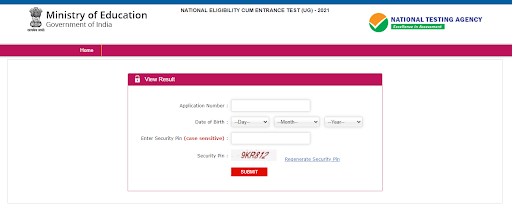
- Click on the “View NEET-UG 2024 – Result” option available on the screen.
- On the NEET candidate login page, input your roll number, Date of Birth, and the security pin provided on the page.
- The NEET 2024 rank card will then be displayed on the screen.
- Download your NEET 2024 result by selecting the ‘Print’ option and save it.
Candidates are advised to keep a copy of their NTA NEET 2024 result in PDF format for their records, which should be retained until the conclusion of the admission process.
NEET Result 2024 – Details Mentioned
The following are the details that should be mentioned in the NEET 2024 Result:-
- Candidate’s Roll Number
- Application Number
- Personal Details (including candidate’s name, father’s and mother’s name, gender, DOB, nationality, category/sub-category, etc.)
- Percentile obtained in Physics, Chemistry, and Biology (Botany and Zoology)
- Total Marks obtained
- Percentile Score
- NEET 2023 All India Rank
- NEET Qualifying Status
- NEET AIR for 15% AIQ seats
- NEET Cutoff Score
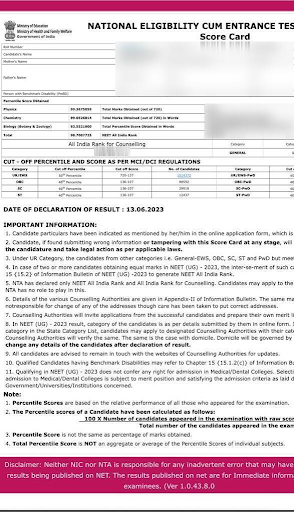
NEET 2024 cutoff
Since the NEET 2024 Exam has not yet been conducted. Therefore, we are providing you with the NEET 2023 Cutoff so as to get a fair idea of marks one needs to score to get into their desired institutes:-
| Category | Qualifying criteria | Marks range | Number of candidates |
| UR/EWS | 50th Percentile | 720-137 | 1014372 |
| OBC | 40th Percentile | 136-107 | 88592 |
| SC | 40th Percentile | 136-107 | 29918 |
| ST | 40th Percentile | 136-107 | 12437 |
| UR / EWS & PH | 45th Percentile | 136-121 | 405 |
| OBC & PH | 40th Percentile | 120-107 | 179 |
| SC & PH | 40th Percentile | 120-107 | 50 |
| ST & PH | 40th Percentile | 120-108 | 23 |
NEET 2024 Counseling
NEET 2024 counseling is the process by which eligible candidates who have qualified in the National Eligibility cum Entrance Test (NEET) can secure admission to undergraduate medical (MBBS) and dental (BDS) courses in various colleges and universities across India. Here are the key points regarding NEET 2024 counseling:
- Centralized and State Counseling: NEET 2024 counseling can be conducted at the central (All India Quota) or state levels, depending on the type of seats (central or state) for which candidates are eligible.
- All India Quota (AIQ): The All India Quota includes 15% of the total seats in government medical and dental colleges across India. Counseling for AIQ seats is conducted by the Directorate General of Health Services (DGHS).
- State Quota: The remaining 85% of seats in government medical and dental colleges are under the control of respective state authorities. Each state conducts its own counseling for these seats.
- Private Colleges: Counseling is also held for seats in private medical and dental colleges in each state.
- Deemed Universities: Deemed universities conduct their own counseling for MBBS and BDS courses.
- MCC and State Authorities: The Medical Counseling Committee (MCC) oversees central counseling for AIQ seats, while state counseling is managed by respective state authorities.
- Choice Filling and Seat Allotment: During counseling, candidates choose their preferred colleges and courses, and seats are allocated based on their NEET 2024 rank and choices.
- Document Verification: Candidates are required to provide documents for verification to confirm their eligibility.
- Seat Locking and Acceptance: After seat allocation, candidates must accept the seat within a stipulated time frame. Failure to do so may result in seat forfeiture.
- Upgradation: Candidates may have the option to upgrade their allotted seats to their preferred choices in subsequent rounds of counseling.
- Round-wise Counseling: Counseling is typically conducted in multiple rounds, allowing candidates to improve their choices and secure better seats.
- Admission Fee: Candidates must pay the prescribed admission fee to confirm their seats.
- Reporting to Colleges: After seat allocation, candidates must report to the allotted colleges for admission formalities.
Is it compulsory to take the NEET exam?
In India, the National Eligibility cum Entrance Test (NEET) is the mandatory entrance examination for students who wish to pursue undergraduate medical (MBBS), dental (BDS), or related courses in recognized medical and dental colleges across the country. NEET is a compulsory examination for Indian and overseas candidates seeking admission to these programs. It is conducted by the National Testing Agency (NTA) and is a critical step in the admission process for medical and dental courses. Students must qualify in NEET 2024 to be eligible for admission to such programs. Therefore, taking the NEET 2024 exam is compulsory for those aspiring to pursue undergraduate medical and dental education in India.
NEET UG 2024 FAQs
Q What is NEET 2024?
Ans NEET 2024 is the National Eligibility cum Entrance Test, a standardized examination in India for admission to undergraduate medical and dental programs.
Q Who conducts NEET 2024?
Ans NEET 2024 is conducted by the National Testing Agency (NTA), an autonomous organization under the Ministry of Education, Government of India.
Q What courses does NEET 2024 cover?
Ans NEET 2024 is primarily for admission to MBBS and BDS courses in medical and dental colleges. It also covers other medical and related programs.
Q What is the eligibility criteria for NEET 2024?
Ans To be eligible for NEET 2024 , a candidate must have passed the 10+2 examination with Physics, Chemistry, and Biology/Biotechnology. They must also have obtained a minimum of 50% marks in these subjects (40% for reserved categories).
Q Is NEET 2024 mandatory for all medical colleges in India?
Ans NEET 2024 is mandatory for admission to all medical and dental colleges in India, including government, private, and deemed universities.
Q Can NRI or foreign candidates apply for NEET 2024?
Ans Yes, NRI and foreign candidates can apply for NEET 2024 for admission to medical and dental courses in India. They should check the eligibility criteria specified for them.
Conclusion
The NEET UG 2024 is expected to take place on May 5, 2024 with the result expected to be declared in the 2nd week of June 2024. Conducted by the National Testing Agency (NTA), NEET 2024 is a critical examination for aspiring doctors and dentists, and it ensures a standardized and merit-based admission process. NEET 2024 Exam’s comprehensive syllabus, eligibility criteria, and counseling procedures help streamline the selection of candidates for various medical programs. With the aim of maintaining high academic standards and providing equal opportunities, NEET 2024 continues to play a pivotal role in shaping the future of the medical profession in the country.
Also See :
- NEET UG 2024
- NEET UG Application form 2024
- NEET Exam pattern 2024
- NEET Admit card 2024
- NEET Syllabus 2024
- NEET Result 2024